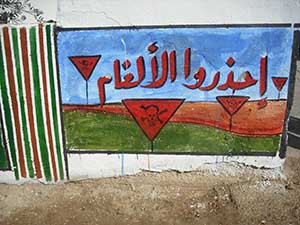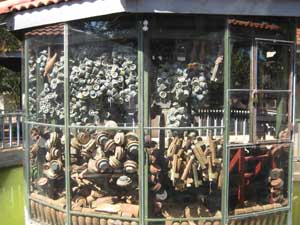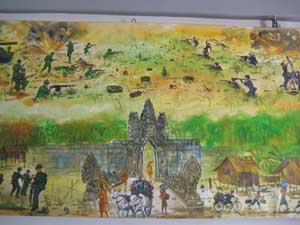Landmine Aging Study
In 2014, landmines claimed average of ten lives per day around the world, according to the Landmine and Cluster Munition Monitor. Around 80 percent of those victims were civilians, with the majority being women and children.
States and countries that are no longer experiencing war are still forced to live with the dangers of landmines and other explosives that did not detonate during conflict. These devices, which are called Explosive Remnants of War (ERW), pose serious threats to civilians living in post-conflict communities. ERWs often sit untouched for many years, causing degradation due to exposure to weather and climate conditions.
In 2008, James Madison University and the Center for International Stabilization and Recovery (CISR) received a grant of $273,755.79 from the U.S. Department of State, Bureau of Political-Military Affairs, Office of Weapons Removal and Abatement (PM/WRA) to start a two-year study on the effects of the deterioration on aging landmines. CISR conducted this study of aged ERWs in Cambodia, Jordan, and the Falkland Islands to assess the impact of weather on ERWs across vastly different climates.
During the fieldwork portion of the research process, CISR worked with demining organizations in Cambodia and Jordan to extract landmine samples. Deminers located, excavated and recovered explosives so that they could be safely broken down and evaluated in on-site laboratories. The researchers then conducted detonation tests to determine the levels of functionality of the aged explosives.
In addition to the initial observations, the team selected mine and soil samples to send to JMU for further research. JMU's science departments analyzed the provided materials and studied how certain environments affected each type of explosive. For instance, the study found that exposure extreme heat or fire causes little to no damage to mines made of metal. Conversely, the plastic components of mine samples showed significant physical deterioration. JMU's in-depth examination of the mine and soil samples gave the landmine action community the ability to predict how landmines react to particular climates.
CISR's landmine aging research helped pave the way for new techniques, policies and practices on the removal and disarmament of aged ERWs. Additionally, the study brought attention to outdated images that were being used in landmine risk education programs.
Cambodia: Hot, wet climate
CISR's landmine aging research team conducted their hot, wet climate fieldwork in the northeast region of Cambodia. Of the 18 types of landmines identified, 16 were brought back to JMU for further analysis. Through their research, CISR found that most of the explosives recovered in Cambodia were incapable of functioning due to substantial damage. Wooden casings had rotted, metal components were rusted and rubber covers were missing, depending on the type of mine. According to the study, large amounts of water acting on vulnerable materials such as wood and plastic caused the accelerated degradation of the landmines in Cambodia.
**Waiting on email from Brenna to elaborate on the human element of these findings**
Jordan: Hot, dry climate
In Jordan, CISR collected landmine samples from the northern region of the country along the Syrian border. Of the 21 mine samples, nine were transported to JMU for analysis. According to CISR's findings, exposure to fire is the main cause of landmine deterioration in Jordan because the heat breaks waterproof seals and allows outside elements to decrease the functionality of the mines. Otherwise, Jordan's desert-like climate seemed to have very little effect on aging landmines. Only superficial deterioration such as fading colors and minimal external rust disturbed the recovered explosives. The team even found World War II mines that were still functional.
CISR's research suggests that civilians living in hot, dry, mine-affected areas are at a larger risk of suffering injuries or death due to ERWs. **Waiting on email from Brenna to elaborate on the human element of these findings**
Falkland Islands: Cold, wet climate
CISR incorporated pre-existing data from the Falkland Islands into their study. Similar to Jordan, the existing ERWs in the Falkland Islands showed little to no damage and most were fully functional. Spanish and Italian landmines in this area were made out of more durable materials than the explosives in Cambodia, which allowed them to endure the wet environment of the Falklands.


